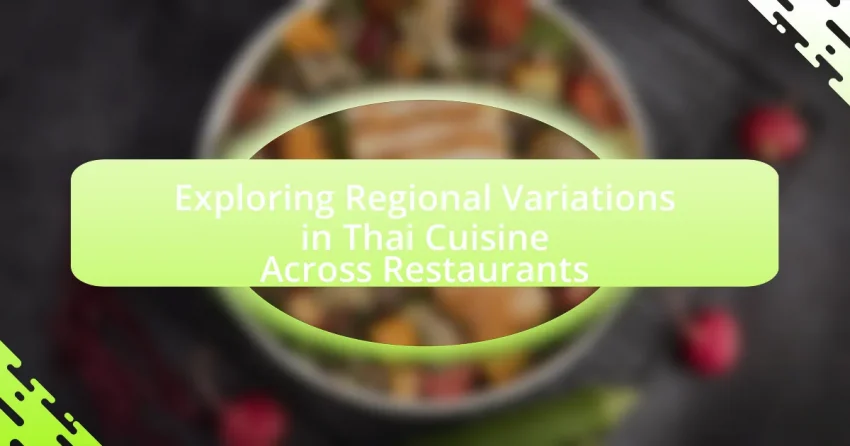The article focuses on exploring regional variations in Thai cuisine as represented in restaurants. It highlights the key characteristics of Thai cuisine, including its balance of flavors and the use of fresh ingredients, while examining how regional ingredients influence specific dishes. The article discusses the cultural significance of food presentation, the impact of festivals on culinary practices, and the historical influences that shape regional dishes. Additionally, it addresses the challenges of authenticity in restaurant offerings and provides insights into how diners can appreciate and identify authentic regional dishes. Overall, the article emphasizes the rich diversity of Thai cuisine across different regions and its representation in dining establishments.

What are the key characteristics of Thai cuisine?
Thai cuisine is characterized by its balance of five fundamental flavors: sweet, sour, salty, bitter, and spicy. This intricate flavor profile is achieved through the use of fresh herbs and spices, such as lemongrass, galangal, and chili, which are essential in creating dishes like Tom Yum soup and Pad Thai. Additionally, Thai cuisine emphasizes the use of fresh ingredients, often incorporating vegetables, seafood, and meats that reflect the country’s agricultural diversity. The cooking techniques, including stir-frying, steaming, and grilling, further enhance the flavors and textures of the dishes. The cultural significance of food presentation in Thai cuisine also plays a crucial role, as meals are often served in a visually appealing manner, reflecting the importance of aesthetics in Thai culture.
How do regional ingredients influence Thai dishes?
Regional ingredients significantly influence Thai dishes by shaping their flavors, textures, and overall culinary identity. For instance, northern Thai cuisine often features ingredients like sticky rice and fresh herbs, which contribute to dishes such as Khao Soi, a coconut curry noodle soup. In contrast, southern Thai cuisine utilizes seafood and coconut milk, evident in dishes like Massaman curry, reflecting the coastal geography and agricultural practices of the region. This diversity is further supported by the Thai government’s promotion of local ingredients through initiatives like the “One Tambon One Product” program, which encourages the use of regional specialties in cooking. Such initiatives highlight the importance of local sourcing in preserving the unique characteristics of Thai cuisine across different regions.
What are the staple ingredients in Northern Thai cuisine?
The staple ingredients in Northern Thai cuisine include sticky rice, fresh herbs, chili, garlic, and fermented fish sauce. Sticky rice serves as a primary carbohydrate source, while fresh herbs like cilantro and mint add flavor. Chili and garlic are essential for heat and aroma, and fermented fish sauce contributes umami and depth to dishes. These ingredients reflect the region’s agricultural practices and cultural influences, emphasizing a balance of flavors and textures characteristic of Northern Thai dishes.
How do Southern Thai spices differ from those in Central Thailand?
Southern Thai spices are characterized by their bold, intense flavors and the frequent use of ingredients like turmeric, shrimp paste, and coconut milk, while Central Thai spices tend to be more balanced and milder, often incorporating ingredients such as lemongrass, galangal, and kaffir lime leaves. The distinct use of spices in Southern Thailand reflects the region’s coastal geography and cultural influences, leading to dishes that are often spicier and richer compared to the more aromatic and subtly flavored dishes found in Central Thailand. This difference is evident in popular Southern dishes like Massaman curry, which features a complex blend of spices, contrasting with the sweeter and less spicy curries typical of Central Thailand, such as red curry.
What role does culture play in shaping Thai culinary traditions?
Culture plays a fundamental role in shaping Thai culinary traditions by influencing the ingredients, cooking techniques, and dining customs unique to various regions of Thailand. The diverse ethnic groups, historical trade interactions, and religious practices contribute to the rich tapestry of flavors and dishes found in Thai cuisine. For instance, the use of fresh herbs and spices, such as lemongrass and galangal, reflects the agricultural practices and climate of Thailand, while regional specialties like Northern curries or Southern seafood dishes highlight local resources and cultural preferences. Additionally, festivals and communal dining practices reinforce the importance of food in social and cultural identity, making Thai cuisine a dynamic expression of the country’s heritage.
How do festivals and celebrations impact regional Thai dishes?
Festivals and celebrations significantly influence regional Thai dishes by introducing unique ingredients, cooking methods, and traditional recipes that reflect local customs and cultural heritage. For instance, during the Songkran festival, which celebrates the Thai New Year, dishes such as Khao Chae (rice soaked in iced water) become popular, showcasing seasonal ingredients like jasmine flowers and fresh herbs. Additionally, regional variations emerge as local communities adapt their culinary practices to incorporate symbolic foods that represent prosperity and good fortune, such as sticky rice and mango during the harvest festivals. This integration of cultural significance into food not only enhances the culinary diversity of Thai cuisine but also preserves traditional practices, as seen in the use of specific spices and preparation techniques that vary from one region to another.
What are the historical influences on Thai cuisine across regions?
Historical influences on Thai cuisine across regions include the integration of various cultural elements from neighboring countries and trade interactions. For instance, the northern region of Thailand has been influenced by Burmese and Chinese cuisines, evident in dishes like Khao Soi, which features Chinese-style noodles and curry. In the central region, the proximity to the Gulf of Thailand has led to a strong emphasis on seafood, with dishes like Pla Rad Prik showcasing local fish. Southern Thai cuisine reflects Malay and Indian influences, particularly in the use of spices and coconut milk, as seen in Massaman curry. Additionally, the historical trade routes facilitated the introduction of ingredients such as chili peppers and herbs, which are now staples in Thai cooking. These regional variations highlight the diverse historical interactions that have shaped Thai cuisine.

How do regional variations manifest in Thai restaurants?
Regional variations in Thai restaurants manifest through distinct regional dishes, ingredient choices, and cooking techniques that reflect the diverse culinary traditions of Thailand’s regions. For example, Northern Thai cuisine often features dishes like Khao Soi, a coconut curry noodle soup, while Southern Thai cuisine is known for its spicy and seafood-rich dishes such as Gaeng Tai Pla. Additionally, the use of local herbs and spices varies; for instance, the Northeast region incorporates ingredients like lemongrass and galangal more prominently. These variations are rooted in historical, geographical, and cultural influences, showcasing the rich tapestry of Thai culinary heritage across different regions.
What are the most popular regional Thai dishes found in restaurants?
The most popular regional Thai dishes found in restaurants include Pad Thai, Tom Yum Goong, Som Tum, Massaman Curry, and Green Curry. Pad Thai, a stir-fried noodle dish, is widely recognized and often features shrimp or chicken, bean sprouts, and peanuts. Tom Yum Goong, a spicy shrimp soup, is celebrated for its bold flavors from lemongrass and kaffir lime leaves. Som Tum, a green papaya salad, is known for its refreshing taste and spicy kick. Massaman Curry, influenced by Indian cuisine, combines meat with potatoes and peanuts in a rich coconut milk base. Green Curry, characterized by its vibrant color and spiciness, typically includes chicken or beef cooked in coconut milk with green curry paste. These dishes reflect the diverse flavors and ingredients used across Thailand’s regions, making them staples in Thai restaurants globally.
How is Pad Thai prepared differently in various regions?
Pad Thai is prepared differently across various regions of Thailand, with each area incorporating unique ingredients and cooking techniques. In Bangkok, the dish often features a balance of sweet, sour, and salty flavors, using tamarind paste, fish sauce, and sugar, while garnishing with crushed peanuts and lime. In contrast, the southern region may include a spicier version, utilizing fresh chilies and seafood, reflecting the coastal influence. Northern Thailand tends to use a thicker sauce and may incorporate local vegetables, while the northeastern region, known for its bold flavors, often adds fermented fish sauce and a variety of herbs. These regional variations highlight the diverse culinary landscape of Thailand, influenced by local ingredients and cultural preferences.
What unique dishes are exclusive to Isaan restaurants?
Unique dishes exclusive to Isaan restaurants include Som Tum (spicy green papaya salad), Larb (spicy minced meat salad), and Gai Yang (grilled chicken). These dishes are characterized by bold flavors, often incorporating ingredients like fish sauce, lime, and fresh herbs. Som Tum is particularly notable for its combination of sour, spicy, and sweet elements, while Larb is recognized for its use of ground meat mixed with herbs and spices, reflecting the region’s culinary traditions. Gai Yang, marinated in a blend of spices and grilled to perfection, showcases the Isaan preference for grilled meats. These dishes are integral to Isaan cuisine, which emphasizes fresh ingredients and vibrant flavors, distinguishing it from other Thai regional cuisines.
How do restaurant menus reflect regional diversity in Thai cuisine?
Restaurant menus reflect regional diversity in Thai cuisine by showcasing distinct ingredients, cooking techniques, and flavor profiles unique to various Thai regions. For example, menus in Northern Thailand often feature dishes like Khao Soi, a coconut curry noodle soup, while Southern Thai menus may highlight spicy seafood dishes such as Gaeng Tai Pla, which incorporates fermented fish. Additionally, the use of local herbs and spices, such as lemongrass in Central Thai cuisine and turmeric in Southern dishes, further illustrates this diversity. This regional representation on menus not only caters to local tastes but also educates diners about the rich culinary heritage of Thailand, emphasizing the importance of geographical influences on food preparation and presentation.
What are the common themes in menus of Northern Thai restaurants?
Common themes in menus of Northern Thai restaurants include the use of fresh herbs, unique regional ingredients, and a focus on bold flavors. Dishes often feature local staples such as sticky rice, fermented vegetables, and a variety of meats, particularly pork and chicken. Signature dishes like Khao Soi, a coconut curry noodle soup, and Sai Oua, a spicy herbal sausage, highlight the region’s culinary identity. Additionally, Northern Thai cuisine emphasizes the balance of spicy, sour, and savory tastes, often accompanied by fresh vegetables and dipping sauces. This regional focus is rooted in the cultural practices and agricultural products specific to Northern Thailand, making the cuisine distinct from other Thai regions.
How do urban Thai restaurants incorporate regional specialties?
Urban Thai restaurants incorporate regional specialties by sourcing authentic ingredients and adapting traditional recipes to reflect local tastes. For instance, many establishments feature dishes from northern Thailand, such as Khao Soi, alongside southern specialties like Massaman curry, showcasing the diversity of Thai cuisine. Additionally, these restaurants often collaborate with chefs from specific regions to ensure authenticity and may offer seasonal menus that highlight regional festivals or ingredients, reinforcing their commitment to showcasing Thailand’s culinary heritage.

What are the challenges in exploring regional variations in Thai cuisine?
Exploring regional variations in Thai cuisine presents challenges such as the diversity of ingredients, preparation methods, and cultural influences across different regions. Each region in Thailand, including the North, Northeast, Central, and South, has distinct culinary traditions shaped by local agriculture, climate, and historical interactions with neighboring cultures. For instance, Northern Thai cuisine often features ingredients like sticky rice and herbs, while Southern Thai cuisine is known for its use of coconut milk and seafood. Additionally, the availability of authentic regional dishes can be limited in restaurants outside of Thailand, making it difficult to experience the full spectrum of flavors and techniques. This complexity is further compounded by the lack of standardized recipes and the influence of globalization, which can lead to the fusion of traditional dishes with modern culinary trends, obscuring authentic regional characteristics.
How do authenticity and adaptation affect restaurant offerings?
Authenticity and adaptation significantly influence restaurant offerings by shaping menu items and customer experiences. Authenticity ensures that traditional recipes and cooking methods are preserved, appealing to diners seeking genuine cultural experiences, while adaptation allows restaurants to modify these offerings to cater to local tastes and dietary preferences. For instance, a Thai restaurant in the United States may incorporate local ingredients or adjust spice levels to attract a broader audience, thereby enhancing customer satisfaction and increasing patronage. This balance between maintaining authenticity and embracing adaptation is crucial for restaurants to thrive in diverse markets, as evidenced by the growing popularity of fusion cuisines that blend traditional elements with contemporary trends.
What are the risks of misrepresenting regional dishes?
Misrepresenting regional dishes poses significant risks, including cultural appropriation, loss of authenticity, and consumer deception. Cultural appropriation occurs when a dish is presented without respect for its origins, potentially offending the communities that created it. Loss of authenticity can lead to a dilution of traditional recipes and cooking methods, undermining the culinary heritage of a region. Consumer deception arises when diners are misled about the ingredients or preparation methods, which can result in dissatisfaction and mistrust towards restaurants. For instance, a study by the University of California found that 70% of consumers prefer authentic ethnic cuisine, indicating that misrepresentation can negatively impact customer loyalty and business reputation.
How do chefs balance tradition with modern culinary trends?
Chefs balance tradition with modern culinary trends by integrating classic techniques and ingredients with contemporary flavors and presentation styles. This approach allows chefs to honor the cultural heritage of dishes while appealing to evolving consumer preferences. For instance, in Thai cuisine, chefs may use traditional recipes as a foundation but incorporate innovative elements such as fusion ingredients or modern plating techniques to enhance the dining experience. This method not only preserves the authenticity of the cuisine but also attracts a diverse clientele, reflecting the dynamic nature of culinary arts.
What tips can help diners appreciate regional Thai cuisine?
To appreciate regional Thai cuisine, diners should explore the diverse flavors and ingredients unique to each region, such as the use of fresh herbs in Central Thailand or the spiciness of dishes from the Northeast. Understanding the cultural context and traditional cooking methods enhances the dining experience, as many dishes reflect local customs and agricultural practices. For instance, the use of sticky rice in the Northeast is a staple that showcases the region’s agricultural heritage. Engaging with knowledgeable staff or chefs can provide insights into the origins and preparation of dishes, further enriching the appreciation of the cuisine.
How can one identify authentic regional dishes in restaurants?
One can identify authentic regional dishes in restaurants by examining the ingredients, preparation methods, and presentation styles that reflect the specific cultural and historical context of the region. Authentic dishes often utilize local ingredients that are characteristic of the area, such as specific herbs, spices, and proteins unique to that region. For example, in Southern Thai cuisine, dishes frequently feature coconut milk and seafood, while Northern Thai cuisine emphasizes ingredients like sticky rice and herbs. Additionally, the cooking techniques, such as grilling or steaming, can indicate authenticity, as they are often traditional methods passed down through generations. Furthermore, the presence of regional specialties on the menu, along with descriptions that highlight their origins and traditional preparation, can serve as indicators of authenticity.
What are the best practices for exploring Thai cuisine across regions?
To effectively explore Thai cuisine across regions, one should prioritize visiting local markets and street food stalls, as these venues often showcase authentic regional dishes. Engaging with local chefs and food vendors provides insights into traditional cooking methods and ingredients unique to each area. Additionally, participating in cooking classes can enhance understanding of regional flavors and techniques. Researching regional specialties, such as the spicy dishes of the Northeast or the coconut-based curries of the South, further enriches the culinary experience. This approach is validated by the diversity of Thai cuisine, which varies significantly from region to region, reflecting local ingredients and cultural influences.
